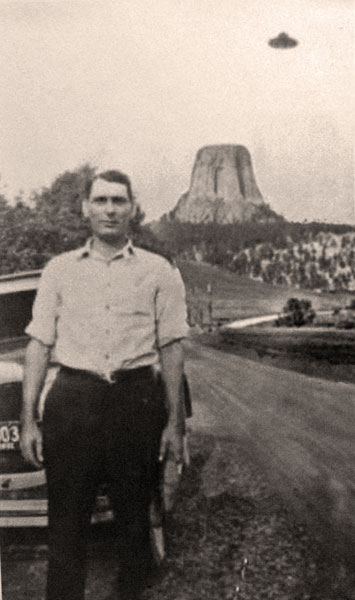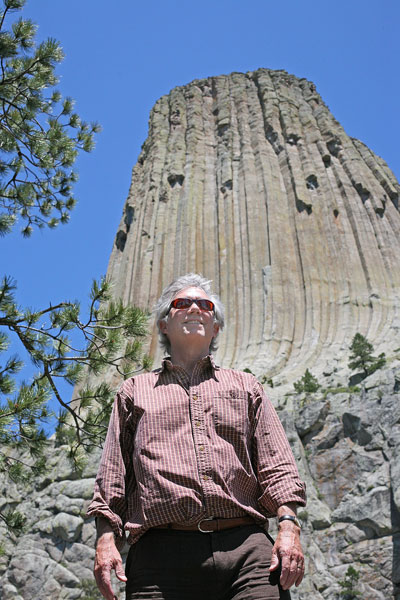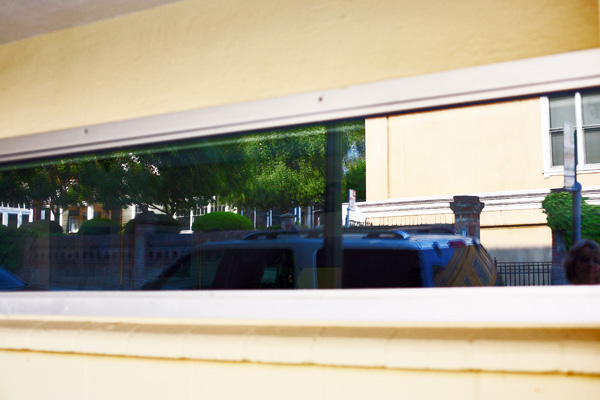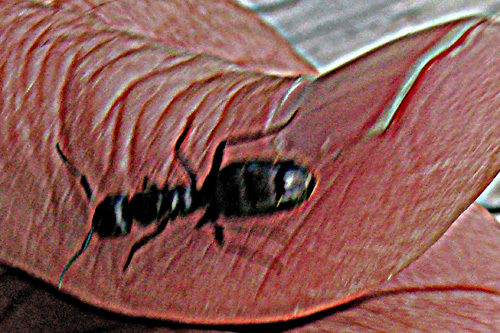The text for today’s post is excerpts from a June 14, 1997, journal entry. I just figured out how to link to specific pages of PDF files, so my lifebox weave can be that much more detailed now!

The entry I’m quoting was written up while I was doing some field rsearch for my out of print but still available novel Saucer Wisdom — in 1997, I actually flew all the way to Devil’s Tower looking for (and finding) the inspiration to finish the book (and stayed with Dick Termes.)
The pictures are from my second trip there, this Juneteenth (I like the vagueness of that useage), 2008, along with a couple of pictures from Rt. 14a through the Big Horn mountains and from the Thumb Lake geyser pool in Yellowstone.

Approaching Devil’s Tower I was excited, thinking about the approach to it in Close Encounters of the Third Kind, how the GOVERNMENT has barricaded off the tower and is trying to keep YOU AND ME from seeing the MAGIC. How persistent and attractive this myth is. The GOVERNMENT stands for what — superego? Mental blocks? I was sharing in the Close Encounters of the Third Kindfeeling bigtime myself, thinking things like “I’m breaking through, I’m going all the way, nobody is gonna stop me.”

My head feels funny from looking at Termes art all evening. Things are like flipping around. And I am living inside a Termes icosahedron—-did I mention that? I’m sleeping in an icosohedral cupola on top of his Bucky-Fuller-dome art gallery. What a wonderful place to be.

I stop and read a marker just as the Tower came first into view. There’s an Indian legend that the Devil’s Tower is that way because a bear clawed it. It’s about 800 ft from base to top. On the radio is that old metal band, Great White, playing “Once Bitten Twice Shy.” Really some fairly convincing sounding Stones riffs in there. Though later I heard the real Stones doing “Beast of Burden,” and you remember that Keith doesn’t just play “Stones riffs,” he plays beautiful tasty surprising things.

The Tower was scored with beautiful smooth grooves. Large grooves. The thing is really a bundle of columns. The columns are hexagonal, sometimes pentagonal, maybe thirty feet across. I suspect that they formed as Bernard convection cells in the quiescently cooling magma. The tower itself is only about 60 columns wide.
I took a path around it, got quite close to the base, though just when was going to touch the thing itself there were some climbers directly overhead and I worried they would kick stone down on me and I felt their yells were disapproving directed at me for being there, a non-climber. I vaporized them with a femtoray. The blocks of stone at the base are called talus.

Incessant wind. Striking animals I saw: chipmunk, red squirrel, yellow swallowtail butterflies, snake, white-tail deer, a quail, prairie dogs. The snake looked so armless. The red squirrel running up a twisty pine tree: it fits, the squirrel fits the tree, the two of them fit my perceptions of what I should see.
We are all DNA, we are all part of the same wetware world. We humans were going by mostly in male-female pairs, couples going around together, why do couples do that so much? Is it from the nesting instinct? He is showing her places she can safely breed their pups?

I went off the trail, just like in Close Encounters of the Third Kind, at the base of the Tower. How terribly isolated it seemed for that guy at the end of Close Encounters of the Third Kind, I think he’d made a huge mistake, going all alone into the giant utility research kitchen of the saucer, the soulless stainless foodless kitchen. But WHOAH before you know it, maybe a door’ll spring open and there will be bloody crazy grinning turncoat human in an alien chef’s hat made of human skin with big toque ears, like the guy in my fen-ignored-but-still-online story, “The Men in the Back Room at the Country Club.”

Sitting there I imagine that a knot of roots is a spider the size of my fist. “My throat grew raw with screaming.”
Near the Belle Fourche River was a pavilion and they were having an event celbrating a book called Leaning Against The Wind, and I heard some women reading things that were in it. I later learned that it’s an anthology of writings by women of the High Plains states. The woman I heard said something about how she and her man had been called low-lifes, for not having cows, but she can see them in the stockyard near her house, she works in the stockyard. Of someone in her family: “He became a successful salesman of cow products.” I naturally wonder: Cows harvested by the aliens?

I drove home through the rolling fields so green, a back road. Thunder storms and then a tornado warning on the radio. Great slashing lines of lightning, some fractal line then gets lit multiple times pulse pulse pulse as the energy courses down the superheated air highway.

R.e. the Midwest, this morning I was getting supplies for the day at Safeway, and I thought of the repetition of the endless Midwestern Safeways by the interstates, the Safeways and their identically polite checker girls with Norwegian oooo sounds in their speech. And the repetition of the old farmers and farmwives, spry and cantankerous, making the best of things. The endless glut of us humans repeated over and over with the same expressions and opinions, we are like a field of flowers, all of us more or less the same — well, why not, that’s how fields of flowers are, all the same, and it’s just a Romantic error to expect the windrows of humanity to be anything other than fields of people, the same pattern duplicated and reduplicated, Nature likes repeating herself.

BUT, anent the aliens, as I thought of the flower-flesh I could see the deep disinterest which the aliens would have in us, and how shallow our imagined differences would be relative to them, a slight bend of one petal, it’s still just another buttercup, the aliens must have as deep a don’t-care as my feeling on seeing yet another squirming black cricket in the clods of the field I walked across the morning, past the rotting bodies of the road-kill deer, laid out for the scavenger American Eagles, and no I won’t be stopped from telling this True Story, and you reading this, yes, you aren’t letting Them stop you, you’re in the Big Time now.

It’s good to be an alien.
















































